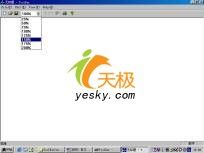VC++实现工具栏上添加平面组合框控件
使用过OFFICE2000的人都知道,它的界面,尤其是菜单和工具条,可谓是让人耳目一新。虽然Visual C++开发工具也提供了对工具条的支持,但通常只是按纽的集合,不能直接加入组合框等控件,实现OFFICE2000风格的工具条。本实例针对其中的一个细节,讲述了在Windows环境下用Visual C++6.0在工具条中加入平面组合框控件方法,并实现了组合框的消息响应函数,使得我们的程序看上去更加专业。程序编译运行后的效果如图一所示:
一、实现方法
用应用程序向导(AppWizard)生成一个基于单文档的工程(Project),首先打开VC的工具条资源编辑器,在工具条要加入组合框的地方加一个空按纽,并将资源共享ID定义为ID_TOOL_ZOOM。
其次,从面向对象的思想出发,一个工具条作为一个整体,应该封装为一个类,组合框控件应该作为这个类的一个成员变量。因此用Visual C++的类向导CLASSWIZARD生成一个以CToolBar为基类的的新类CMainToolBar,并加入成员变量CFlatComboBox m_combobox(CflatComboBox为平面组合框类。
在向工具条添加控件的过程中,调用CToolBar::GetItemID()函数来获取每个按钮的ID,直到搜索到"空"按钮。 CToolBar::GetItemID()函数的原型为:UINT GetItemID( int nIndex ) const,参数nIndex为当前按钮在工具条中的索引号,该索引号的基准值为"0"。找到"空"按钮后,调用 CToolBar::SetButtonInfo()函数设置按钮的宽度信息。最后调用CComBox::Create()、 CcomBox::AddString()等函数动态创建平面组合框控件,下面的代码实现了平面组合框控件的动态创建:
但是仅仅产生平面组合框是不够的,必须实现组合框的消息响应函数,才能方便地运用组合框。在Vsiaul C++中,消息响应函数通常都是用类向导来实现,但是此处由于组合框是用函数创建的,所以必须亲自动手来写代码,也并不麻烦,与类向导生成的代码格式是一样的,可以参照来写。下面代码定义了组合框的选择变化消息响应函数:
二、编程步骤
1、启动Visual C++6.0,生成一个单文档项目,将该项目命名为"ToolBar";
2、通过资源编辑器新增一个工具按钮,"Caption"设置为空,ID资源标志符命名为ID_TOOL_ZOOM;
3、启动Class Wizard从CToolBar派生一个新类CMainToolBar;
4、在MainFrm.h文件中添加#include "MainToolBar.h"语句,然后找到 CToolBar m_wndToolBar语句,用CMainToolBar代替CToolBar;
5、添加代码,编译运行程序。
三、程序代码
四、小结
为了实现OFFICE2000风格的工具条,本实例介了一种比较巧妙的方法,利用Visual C++6.0已有的开发环境支持,在工具条中加入了平面组合框控件,并实现了组合框的消息响应,用户选择组合框中的某一项后,会弹出一个对话框,提示用户所选择的信息。

图一、工具栏中的平面组合框控件 |
一、实现方法
用应用程序向导(AppWizard)生成一个基于单文档的工程(Project),首先打开VC的工具条资源编辑器,在工具条要加入组合框的地方加一个空按纽,并将资源共享ID定义为ID_TOOL_ZOOM。
其次,从面向对象的思想出发,一个工具条作为一个整体,应该封装为一个类,组合框控件应该作为这个类的一个成员变量。因此用Visual C++的类向导CLASSWIZARD生成一个以CToolBar为基类的的新类CMainToolBar,并加入成员变量CFlatComboBox m_combobox(CflatComboBox为平面组合框类。
在向工具条添加控件的过程中,调用CToolBar::GetItemID()函数来获取每个按钮的ID,直到搜索到"空"按钮。 CToolBar::GetItemID()函数的原型为:UINT GetItemID( int nIndex ) const,参数nIndex为当前按钮在工具条中的索引号,该索引号的基准值为"0"。找到"空"按钮后,调用 CToolBar::SetButtonInfo()函数设置按钮的宽度信息。最后调用CComBox::Create()、 CcomBox::AddString()等函数动态创建平面组合框控件,下面的代码实现了平面组合框控件的动态创建:
| //设置指定工具项的宽度并获取新的区域 80是宽度 m_wndToolBar.SetButtonInfo(index, ID_TOOL_ZOOM, TBBS_SEPARATOR, 80); m_wndToolBar.GetItemRect(index, &rect); //设置位置 rect.top+=2; rect.bottom += 200; // 创建并显示 if (!m_wndToolBar.m_wndZoom.Create(WS_CHILD|WS_VISIBLE | CBS_AUTOHSCROLL|CBS_DROPDOWNLIST | CBS_HASSTRINGS ,rect, &m_wndToolBar, ID_TOOL_ZOOM)) { TRACE0("Failed to create combo-box\n"); return FALSE; } m_wndToolBar.m_wndZoom.ShowWindow(SW_SHOW); //填充内容 m_wndToolBar.m_wndZoom.AddString("25%"); m_wndToolBar.m_wndZoom.AddString("50%"); m_wndToolBar.m_wndZoom.AddString("75%"); m_wndToolBar.m_wndZoom.AddString("100%"); m_wndToolBar.m_wndZoom.AddString("125%"); m_wndToolBar.m_wndZoom.AddString("150%"); m_wndToolBar.m_wndZoom.AddString("175%"); m_wndToolBar.m_wndZoom.AddString("200%"); m_wndToolBar.m_wndZoom.SetCurSel(3); |
但是仅仅产生平面组合框是不够的,必须实现组合框的消息响应函数,才能方便地运用组合框。在Vsiaul C++中,消息响应函数通常都是用类向导来实现,但是此处由于组合框是用函数创建的,所以必须亲自动手来写代码,也并不麻烦,与类向导生成的代码格式是一样的,可以参照来写。下面代码定义了组合框的选择变化消息响应函数:
| /////////////////////////////////////////////////////////////////////////////////////////////// BEGIN_MESSAGE_MAP(CMainFrame, CFrameWnd) //{{AFX_MSG_MAP(CMainFrame) ON_WM_CREATE() ON_CBN_SELENDOK(ID_TOOL_ZOOM, OnSelectZoomed) //}}AFX_MSG_MAP END_MESSAGE_MAP() ////////////////////////////////////////////////////////////////////////////////////////////// afx_msg void OnSelectZoomed(); |
二、编程步骤
1、启动Visual C++6.0,生成一个单文档项目,将该项目命名为"ToolBar";
2、通过资源编辑器新增一个工具按钮,"Caption"设置为空,ID资源标志符命名为ID_TOOL_ZOOM;
3、启动Class Wizard从CToolBar派生一个新类CMainToolBar;
4、在MainFrm.h文件中添加#include "MainToolBar.h"语句,然后找到 CToolBar m_wndToolBar语句,用CMainToolBar代替CToolBar;
5、添加代码,编译运行程序。
三、程序代码
| //////////////////////////////////////////////////// // FlatComboBox.h : header file #if !defined(FLATCOMBOBOX_H_INCLUDED) #define FLATCOMBOBOX_H_INCLUDED #if _MSC_VER > 1000 #pragma once #endif // _MSC_VER > 1000 #define FC_DRAWNORMAL 0x00000001 #define FC_DRAWRAISED 0x00000002 #define FC_DRAWPRESSD 0x00000004 // CFlatComboBox window class CFlatComboBox : public CComboBox { // Construction public: CFlatComboBox(); // Attributes public: bool m_bLBtnDown; COLORREF m_clrHilite; COLORREF m_clrShadow; COLORREF m_clrDkShad; COLORREF m_clrButton; // Operations public: void DrawCombo(DWORD dwStyle, COLORREF clrTopLeft, COLORREF clrBottomRight); int Offset(); // Overrides // ClassWizard generated virtual function overrides //{{AFX_VIRTUAL(CFlatComboBox) //}}AFX_VIRTUAL // Implementation public: virtual ~CFlatComboBox(); // Generated message map functions protected: //{{AFX_MSG(CFlatComboBox) afx_msg void OnMouseMove(UINT nFlags, CPoint point); afx_msg void OnLButtonDown(UINT nFlags, CPoint point); afx_msg void OnLButtonUp(UINT nFlags, CPoint point); afx_msg void OnTimer(UINT nIDEvent); afx_msg void OnPaint(); //}}AFX_MSG DECLARE_MESSAGE_MAP() }; #endif // !defined(FLATCOMBOBOX_H_INCLUDED) /////////////////////////////////////////// #include "stdafx.h" #include "FlatComboBox.h" #ifdef _DEBUG #define new DEBUG_NEW #undef THIS_FILE static char THIS_FILE[] = __FILE__; #endif ///////////////////////////////// CFlatComboBox CFlatComboBox::CFlatComboBox() { m_bLBtnDown = false; } CFlatComboBox::~CFlatComboBox() {} BEGIN_MESSAGE_MAP(CFlatComboBox, CComboBox) //{{AFX_MSG_MAP(CFlatComboBox) ON_WM_MOUSEMOVE() ON_WM_LBUTTONDOWN() ON_WM_LBUTTONUP() ON_WM_TIMER() ON_WM_PAINT() //}}AFX_MSG_MAP END_MESSAGE_MAP() ///////////////////////////////// CFlatComboBox message handlers void CFlatComboBox::OnMouseMove(UINT nFlags, CPoint point) { SetTimer(1,10,NULL); CComboBox::OnMouseMove(nFlags, point); } void CFlatComboBox::OnLButtonDown(UINT nFlags, CPoint point) { m_bLBtnDown = true; CComboBox::OnLButtonDown(nFlags, point); } void CFlatComboBox::OnLButtonUp(UINT nFlags, CPoint point) { m_bLBtnDown = false; Invalidate(); CComboBox::OnLButtonUp(nFlags, point); } void CFlatComboBox::OnTimer(UINT nIDEvent) { POINT pt; GetCursorPos(&pt); CRect rcItem; GetWindowRect(&rcItem); static bool bPainted = false; // OnLButtonDown, show pressed. if (m_bLBtnDown==true) { KillTimer (1); if (bPainted == true) { DrawCombo(FC_DRAWPRESSD, ::GetSysColor(COLOR_BTNSHADOW),::GetSysColor(COLOR_BTNHIGHLIGHT)); bPainted = false; } return; } // If mouse leaves, show flat. if (!rcItem.PtInRect(pt)) { KillTimer (1); if (bPainted == true) { DrawCombo(FC_DRAWNORMAL, ::GetSysColor(COLOR_BTNFACE), ::GetSysColor(COLOR_BTNFACE)); bPainted = false; } return; } // On mouse over, show raised. else { if (bPainted == true) return; else { bPainted = true; DrawCombo(FC_DRAWRAISED, ::GetSysColor(COLOR_BTNSHADOW), ::GetSysColor(COLOR_BTNHIGHLIGHT)); } } CComboBox::OnTimer(nIDEvent); } void CFlatComboBox::OnPaint() { Default(); DrawCombo(FC_DRAWNORMAL, ::GetSysColor(COLOR_BTNFACE),::GetSysColor(COLOR_BTNFACE)); } void CFlatComboBox::DrawCombo(DWORD dwStyle, COLORREF clrTopLeft, COLORREF clrBottomRight) { CRect rcItem; GetClientRect(&rcItem); CDC* pDC = GetDC(); // Cover up dark 3D shadow. pDC->Draw3dRect(rcItem, clrTopLeft, clrBottomRight); rcItem.DeflateRect(1,1); if (!IsWindowEnabled()) { pDC->Draw3dRect(rcItem, ::GetSysColor(COLOR_BTNHIGHLIGHT), ::GetSysColor(COLOR_BTNHIGHLIGHT)); } else { pDC->Draw3dRect(rcItem, ::GetSysColor(COLOR_BTNFACE),::GetSysColor(COLOR_BTNFACE)); } // Cover up dark 3D shadow on drop arrow. rcItem.DeflateRect(1,1); rcItem.left = rcItem.right-Offset(); pDC->Draw3dRect(rcItem, ::GetSysColor(COLOR_BTNFACE), ::GetSysColor(COLOR_BTNFACE)); // Cover up normal 3D shadow on drop arrow. rcItem.DeflateRect(1,1); pDC->Draw3dRect(rcItem, ::GetSysColor(COLOR_BTNFACE), ::GetSysColor(COLOR_BTNFACE)); if (!IsWindowEnabled()) { return; } switch (dwStyle) { case FC_DRAWNORMAL: rcItem.top -= 1; rcItem.bottom += 1; pDC->Draw3dRect(rcItem, ::GetSysColor(COLOR_BTNHIGHLIGHT),::GetSysColor(COLOR_BTNHIGHLIGHT)); rcItem.left -= 1; pDC->Draw3dRect(rcItem, ::GetSysColor(COLOR_BTNHIGHLIGHT),::GetSysColor(COLOR_BTNHIGHLIGHT)); break; case FC_DRAWRAISED: rcItem.top -= 1; rcItem.bottom += 1; pDC->Draw3dRect(rcItem, ::GetSysColor(COLOR_BTNHIGHLIGHT),::GetSysColor(COLOR_BTNSHADOW)); break; case FC_DRAWPRESSD: rcItem.top -= 1; rcItem.bottom += 1; rcItem.OffsetRect(1,1); pDC->Draw3dRect(rcItem, ::GetSysColor(COLOR_BTNSHADOW),::GetSysColor(COLOR_BTNHIGHLIGHT)); break; } ReleaseDC(pDC); } int CFlatComboBox::Offset() { // Thanks to Todd Brannam for this suggestion... return ::GetSystemMetrics(SM_CXHTHUMB); } /////////////////////////// MainToolBar.h: interface for the CMainToolBar class. #if !defined(AFX_MAINTOOLBAR_H__76CF28F4_005F_11D7_8F58_00E04C0BECE6__INCLUDED_) #define AFX_MAINTOOLBAR_H__76CF28F4_005F_11D7_8F58_00E04C0BECE6__INCLUDED_ #if _MSC_VER > 1000 #pragma once #endif // _MSC_VER > 1000 #include "FlatComboBox.h" class CMainToolBar : public CToolBar { public: CMainToolBar(); virtual ~CMainToolBar(); public: CFlatComboBox m_wndZoom; }; #endif ////////////// MainToolBar.cpp: implementation of the CMainToolBar class. #include "stdafx.h" #include "ToolBar.h" #include "MainToolBar.h" #ifdef _DEBUG #undef THIS_FILE static char THIS_FILE[]=__FILE__; #define new DEBUG_NEW #endif CMainToolBar::CMainToolBar() {} CMainToolBar::~CMainToolBar() {} //////////////////////////////////////////////////////////// int CMainFrame::OnCreate(LPCREATESTRUCT lpCreateStruct) { if (CFrameWnd::OnCreate(lpCreateStruct) == -1) return -1; if (!m_wndToolBar.CreateEx(this, TBSTYLE_FLAT, WS_CHILD | WS_VISIBLE | CBRS_TOP| CBRS_GRIPPER | CBRS_TOOLTIPS | CBRS_FLYBY | CBRS_SIZE_DYNAMIC) ||!m_wndToolBar.LoadToolBar(IDR_MAINFRAME)) { TRACE0("Failed to create toolbar\n"); return -1; // fail to create } if (!m_wndStatusBar.Create(this) || !m_wndStatusBar.SetIndicators(indicators, sizeof(indicators)/sizeof(UINT))) { TRACE0("Failed to create status bar\n"); return -1; // fail to create } // TODO: Delete these three lines if you don't want the toolbar to be dockable m_wndToolBar.EnableDocking(CBRS_ALIGN_ANY); EnableDocking(CBRS_ALIGN_ANY); DockControlBar(&m_wndToolBar); int index = 0; RECT rect; //找到指定的工具项 while(m_wndToolBar.GetItemID(index)!=ID_TOOL_ZOOM) index++; //设置指定工具项的宽度并获取新的区域 80是宽度 m_wndToolBar.SetButtonInfo(index, ID_TOOL_ZOOM, TBBS_SEPARATOR, 80); m_wndToolBar.GetItemRect(index, &rect); //设置位置 rect.top+=2; rect.bottom += 200; // 创建并显示 if (!m_wndToolBar.m_wndZoom.Create(WS_CHILD|WS_VISIBLE | CBS_AUTOHSCROLL|CBS_DROPDOWNLIST | CBS_HASSTRINGS ,rect, &m_wndToolBar, ID_TOOL_ZOOM)) { TRACE0("Failed to create combo-box\n"); return FALSE; } m_wndToolBar.m_wndZoom.ShowWindow(SW_SHOW); //填充内容 m_wndToolBar.m_wndZoom.AddString("25%"); m_wndToolBar.m_wndZoom.AddString("50%"); m_wndToolBar.m_wndZoom.AddString("75%"); m_wndToolBar.m_wndZoom.AddString("100%"); m_wndToolBar.m_wndZoom.AddString("125%"); m_wndToolBar.m_wndZoom.AddString("150%"); m_wndToolBar.m_wndZoom.AddString("175%"); m_wndToolBar.m_wndZoom.AddString("200%"); m_wndToolBar.m_wndZoom.SetCurSel(3); return 0; } void CMainFrame::OnSelectZoomed() { CString strContent; m_wndToolBar.m_wndZoom.GetWindowText(strContent); AfxMessageBox(strContent); } |
四、小结
为了实现OFFICE2000风格的工具条,本实例介了一种比较巧妙的方法,利用Visual C++6.0已有的开发环境支持,在工具条中加入了平面组合框控件,并实现了组合框的消息响应,用户选择组合框中的某一项后,会弹出一个对话框,提示用户所选择的信息。